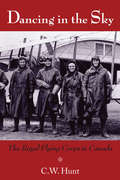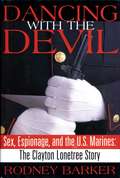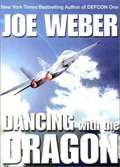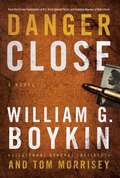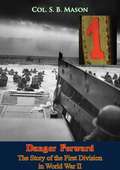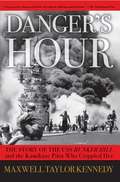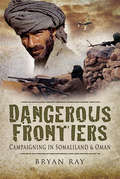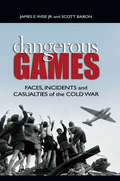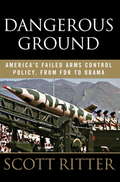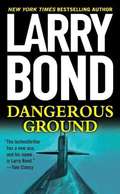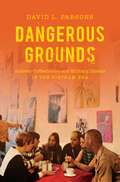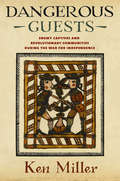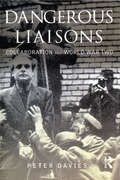- Table View
- List View
Dancing in the Sky: The Royal Flying Corps in Canada
by C. W. HuntDancing in the Sky is the first complete telling of the First World War fighter pilot training initiative established by the British in response to the terrible losses occurring in the skies over Europe in 1916. This program, up and running in under six months despite enormous obstacles, launched Canada into the age of flight ahead of the United States. The results enabled the Allies to regain control of the skies and eventually win the war, but at a terrible price. Flying was in its infancy and pilot training primitive. This is the story of the talented and courageous men and women who made the training program a success, complete with the romance, tragedy, humour, and pathos that accompany an account of such heroic proportions. A valuable addition to Canada’s military history, this book will appeal to all who enjoy an exceptional adventure story embedded in Canada’s past.
Dancing on Deansgate (A Salford Saga)
by Freda LightfootWhen World War II brings danger to Manchester, a young woman sent to stay with her criminal uncle must find courage in this saga. Jess Delaney has always longed for independence. But when the Blitz reaches Manchester, she is locked in the cellar by her feckless mother, Lizzie. As bombs rain down from a sky turned blood red with flame, Jess waits for Lizzie to return. But fortunes are fickle, and soon Jess finds herself packed off to live with her tyrant Uncle Bernie, a bullying black marketeer. Though he treats her like a servant, she seeks refuge in the Sally Army and her natural musical talent offers both an escape route and the chance for love. But Uncle Bernie never forgives his niece for refusing to join his illegal schemes and threatens to deprive Jess of her hard-won freedom once and for all. This is a sweeping saga of hope and resilience perfect for fans of Kitty Neale and Rosie Goodwin.
Dancing with Deception
by Catherine McCullaghLove, lies and deceit in occupied Paris: a young nurse finds herself caught between the resistance and the Gestapo. Marisa Carnarvon is an enigma to her family. In 1938 she turns her back on her privileged Sydney lifestyle to become a nurse in a London hospital. <p><p> With conflict looming, she moves to a Red Cross hospital in Paris, totally unprepared for the forces the approaching maelstrom will unleash. In June 1940 the Germans invade Paris and the young nurse is soon pressured by the leader of the local resistance cell to work for the fledgling movement. Marisa's life becomes increasingly precarious with the arrival of a new Gestapo chief who sets out to seduce her, and the hunt for a traitor in the organisation that throws her into the resistance firing line. As war approaches its climax, Marisa's Gestapo lover flees and the young nurse follows. Only now does Marisa finally discover the truth behind the man whose life was a masterpiece of deception.
Dancing with the Devil: Sex, Espionage And The U. S. Marines : The Clayton Lonetree Story
by Rodney BarkerIn this riveting account of one of the most notorious spy cases in Cold War history, Rodney Barker, the author of The Broken Circle and The Hiroshima Maidens, uncovers startling new facts about the head-line-making sex-for-secrets marine spy scandal at the American embassy in Moscow. This is a nonfiction book that reads with all the excitement of an espionage novel.Although national security issues made the case an instant sensation--at one point government officials were calling it "the most serious espionage case of the century"--the human element gave it an unusual pathos, for it was not just secret documents that were at issue, but love, sex, marine pride, and race It began when a Native American marine sergeant named Clayton Lonetree, who was serving as a marine security guard at the American embassy in Moscow, fell in love with a Russian woman, who then recruited him as a spy for the KGB. Soon the story expanded to involve the CIA, diplomats on both sides of the Iron Curtain, and the United States Navy's own investigative service, and before it was over a witch hunt would implicate more marines and ruin many reputations and careers. In the end, charges were dropped against everyone except Lonetree, who after a long and dramatic court-martial was sentenced to thirty years in prison. But so many questions were left unanswered that the scandal would be thought of as one of the great unsolved mysteries of the Cold War. Not any longer. In the process of researching his book, investigative writer Rodney Barker gained access to all the principal characters in this story. He interviewed key U.S. military and intelligence personnel, many of whom were unhappy with the public records and trial, and spoke out with astonishing candor. He traveled to Russia to track down and interview KGB officers involved in the operation, including the beautiful and enigmatic Violetta Seina, who lured Lonetree into the "honey-trap"--only to fall in love with him. And he succeeded in penetrating the wall of silence that has surrounded Clayton Lonetree since his arrest and reports the sergeant's innermost thoughts. A provocative aspect of this story that Barker explores in depth is whether justice was served in Lonetree's court-martial--or whether he was used as a face-saving scapegoat after a majority security failure, or doomed by conflicts within his defense team, between his military attorney and his civilian lawyer William Kunstler, or victimized by an elaborate and devious KGB attempt to cover the traces of a far more significant spy: Aldrich Ames, the "mole" at the very heart of the CIA. Above all, this is a book about Clayton Lonetree, one man trapped by his own impulses and his upbringing, in the final spasms of the Cold War, a curiously touching, complex, and ultimately sympathetic figure who did, in fact, sacrifice everything for love.
Dancing with the Dragon (Scott Dalton and Jackie Sullivan #2)
by Joe WeberIn a page-turning techno-thriller from start to cliff-hanging finish, bestselling author Joe Weber delivers a gripping plot that could have been torn from tomorrow's headlines. During routine night operations off Southern California, an F/A-18 from the USS Abraham Lincoln is inexplicably blown from the sky. The Pentagon wants to throw a blanket over the incident, but then another navy fighter jet is mysteriously destroyed in midair. The president orders an investigation to find out who is responsible for the attacks-and why. Tagged for the job: ex-CIA operatives and former military pilots Scott Dalton and Jackie Sullivan. As Dalton and Sullivan proceed, they are surprised to learn that the loss of the navy jets is just the latest in a series of seemingly unrelated and previously unexplained losses of American combat aircraft. Yet their investigation soon uncovers a deadly conspiracy that seems to lead directly to the heart of Beijing.
Dane (SEALs of Honor #3)
by Dale MayerHe's one of the smartest, the best ... and the baddest. Since Dane achieved his lifelong dream of becoming a Navy Seal, his life has been packed with action ... but now he wants more. Especially after seeing several of his friends find something – someone – special. On a mission hunting a chemical weapons terrorist, Dane runs into a captivating woman, and everything about her touches his deepest needs. But the circumstances are suspicious, and he can’t determine whose side she’s on. Marielle came to Germany for a short busman’s holiday, only to end up running away from the very man she came to see, and into the arms of a man she knows she’ll never be able to keep. As their situation slides from bad to worse to desperate, their lives are on the line. And so are their hearts.
Danger Close (Blake Kershaw Series #1)
by William G. Boykin Tom MorriseyBarely into his twenties and already a highly decorated military hero, Army Special Forces veteran Blake Kershaw is now going to college, studying while recuperating from wounds received in Afghanistan, and planning to re-enter the Army as an officer after graduation. But life tosses Blake a curve when his country approaches him about using his special skills to avert a terrorist plot to detonate a nuclear device in a major eastern U. S. city. To do that, he would need to become an operative deep within Al-Qaeda's innermost circles-- changing his entire identity, even his face. A true patriot, Blake makes the journey into a shadow world that leaves friends, family and, seemingly, even God far behind. But when things go terribly wrong, and his country looks set to destroy him, it is God and God's people who intervene.
Danger Close: Military Romantic Suspense (The Echo Platoon Series #1)
by Marliss MeltonNavy SEAL Sam Sasseville resents being called upon to repeatedly rescue Madison Scott—an oil tycoon's daughter—from trouble of her own making. Just weeks after extracting her from drug-riddled Mexico, Maddy disappears into the terrorist-threatened region of El Chaco, Paraguay.Dedicated to protecting the world's last agricultural frontier from her family-owned oil wells, Maddy knows her long-dead activist mother would approve of her work, even if that blasted Navy SEAL doesn't.But between the terrorists trying to nab her and the shadowy assassin intent on snuffing out her life, Maddy and Sam discover a common goal—keeping her alive—while Sam faces a difficult choice: love Maddy just the way she is, or walk away with just his pride for company.THE ECHO PLATOON SERIES, in orderDanger CloseHard LandingFriendly FireTHE TASKFORCE SERIES, in order The ProtectorThe GuardianThe Enforcer
Danger Close: My Epic Journey as a Combat Helicopter Pilot in Iraq and Afghanistan
by Amber SmithInspiring and “riveting…vivid and harrowing” (Sean Parnell, author of Outlaw Platoon), Danger Close is the first memoir of active combat by a female helicopter pilot in Iraq and Afghanistan. New York Times bestselling author Brad Thor raves, “Men and women alike will love this incredible tale of heroism, humility, and high-octane feats of bravery.”Amber Smith flew into enemy fire in some of the most dangerous combat zones in the world. One of only a few women to fly the Kiowa Warrior helicopter—whose mission, armed reconnaissance, required its pilots to stay low and fly fast, perilously close to the fight—Smith deployed to Iraq and Afghanistan and rose to Pilot-in-Command and Air Mission Commander in the premier Kiowa unit in the Army. She learned how to perform and survive under extreme pressure, both in action against an implacable enemy and within the elite “boy’s club” of Army aviation. In Danger Close, Smith “covers each mission with edge-of-your-seat detail and a coolness that demonstrates how she gained the respect of fellow pilots and soldiers on the ground” (Library Journal). Smith’s unrelenting fight for both mastery and respect delivers universal life-lessons that will be useful to any civilian, from “earning your spurs” as a newbie to “embracing the suck” through setbacks that challenge your self-confidence to learning to trust your gut as a veteran of your profession. Intensely personal, cinematic, poignant, and inspiring, Danger Close is “the captivating story of one woman’s fight to serve her country in the direct line of danger” (Dana Perino, co-host of The Five on Fox News).
Danger Forward: The Story of the First Division in World War II
by Col. S. B. Mason Hanson W. BaldwinNo mission too difficult, no sacrifice too great, duty first.--The motto of the First Division.The heroic, hard-fought history of the "Big Red One" is recorded by the men who fought in the campaigns across North Africa and Europe.A regular army unit, the First Infantry Division was one of the first combat formations to move overseas in WWII. Overseas: 7 August 1942. Campaigns: Algeria-French Morocco, Tunisia, Sicily, Normandy, Northern France, Rhineland, Ardennes, Alsace, Central Europe. Days of Combat: 443. The 1st Infantry Division saw its first combat in World War II in North Africa, landing at Oran and taking part in the initial fighting, 8-10 November 1942. Elements then took part in see-saw combat at Maktar, Medjez el Bab, Kasserine Pass, Gafsa, El Guettar, Beja, and Mateur, 21 January-9 May 1943, helping secure Tunisia. The First was the first ashore in the invasion of Sicily, 10 July 1943; it fought a series of short, fierce battles on the island's tortuous terrain. When that campaign was over, the Division returned to England to prepare for the Normandy invasion. The First Division assaulted Omaha Beach on D-day, 6 June 1944, some units suffering 30 percent casualties in the first hour, and secured Formigny and Caumont in the beachhead. The Division followed up the St. Lô breakthrough with an attack on Marigny, 27 July 1944, and then drove across France in a continuous offensive, reaching the German border at Aachen in September. The Division laid siege to Aachen, taking the city after a direct assault, 21 October 1944. The First then attacked east of Aachen through Hürtgen Forest, driving to the Roer, and moved to a rest area 7 December for its first real rest in 6 months' combat, when the von Rundstedt offensive suddenly broke loose, 16 December. The Division raced to the Ardennes, and fighting continuously from 17 December 1944 to 28 January 1945, helped blunt and turn back the German offensive. Thereupon, the Division attacked and again breached the Siegfried Line, fought across the Roer, 23 February 1945, and drove on to the Rhine, crossing at the Remagen bridgehead, 15-16 March 1945. The Division broke out of the bridgehead, took part in the encirclement of the Ruhr Pocket, captured Paderborn, pushed through the Harz Mountains, and was in Czechoslovakia, at Kinsperk, Sangerberg, and Mnichov, when the war in Europe ended.Richly illustrated with 115 photos and 19 maps.
Danger Planet
by Edmond HamiltonOne million years back in the swirling, shrouded past, evil ultra-beings ruled the Planet Roo. Suddenly, unbelievably, they are alive again, threatening the universe with total destruction.Only one man dares challenge the Evil Ones. He is Captain Future, inter-galactic agent of justice, whose identity is top secret, whose strength is ultimate. He sets out alone to stop the deathless menace creeping ever close...
Danger at Scituate Lighthouse
by Marlene Bateman SullivanDuring the War of 1812, Rebecca’s father leaves her and her sister to watch their family’s lighthouse while he’s in town. As luck would have it, a ship full of British Redcoats drops anchor nearby and threatens to raid their town! All Rebecca has at her disposal are a fife, a drum, and her cleverness. How can she use them to protect her home?
Danger in the Ashes (Ashes #8)
by William W. JohnstoneAn ex-soldier fights the KKK for the fate of post-apocalyptic America in the New York Times–bestselling author&’s military sci-fi thriller. During the years following the nuclear holocaust that decimated the United States, soldier and survivalist Ben Raines dedicated his life to rebuilding civilization from the ruins. But for America to rise again, it needs just laws—with harsh penalties. And Ben Raines is the only man for the job. As the bloody war continues against the hordes of subhuman cannibals infesting the urban wasteland, Raines and his rebel forces encounter an even greater threat to their dream of a new America. The Ku Klux Klan has reawakened to sow the poisonous seeds of ignorance and prejudice. Of all the threats to mankind's survival, blind hatred is the deadliest. And Ben Raines will stop at nothing to wipe out this hideous scourge. Eighth in the long-running series!
Danger in the Deep (Mills And Boon Love Inspired Suspense Ser.)
by Karen KirstA Marine must protect a widow caught in a criminal’s crosshairs in this inspirational romantic suspense thriller.Aquarium employee Olivia Smith isn’t sure why someone wants her dead—but Marine Corps pilot Brady Johnson knows a secret that could explain it. Brady vowed he’d tell no one that Olivia’s husband had been on the run from his own mob family before he died, but he also promised he’d keep Olivia safe. With danger running deep, they’ll have to work fast to stay alive.
Danger's Hour
by Maxwell Taylor KennedyIn the closing months of World War II, Americans found themselves facing a new and terrifying weapon: kamikazes -- the first men to use airplanes as suicide weapons. By the beginning of 1945, American pilots were shooting down Japanese planes more than ten to one. The Japanese had so few metals left that the military had begun using wooden coins and clay pots for hand grenades. For the first time in 800 years, Japan faced imminent invasion. As Germany faltered, the combined strength of every warring nation gathered at Japan's door. Desperate, Japan turned to its most idealistic young men -- the best and brightest college students -- and demanded of them the greatest sacrifice. On the morning of May 11, 1945, days after the Nazi surrender, the USS Bunker Hill -- a magnificent vessel that held thousands of crewmen and the most sophisticated naval technology available -- was holding at the Pacific Theater, 70 miles off the coast of Okinawa. At precisely 9:58 a.m., Kiyoshi Ogawa radioed in to his base at Kanoya, 350 miles from the Bunker Hill, "I found the enemy vessels." After eighteen months of training, Kiyoshi tucked a comrade's poem into his breast pocket and flew his Zero five hours across the Pacific. Now the young Japanese pilot had located his target and was on the verge of fulfilling his destiny. At 10:02.30 a.m., as he hovered above the Bunker Hill, hidden in a mass of clouds, Kiyoshi spoke his last words: "Now, I am nose-diving into the ship." The attack killed 393 Americans and was the worst suicide attack against America until September 11. Juxtaposing Kiyoshi's story with the stories of untold heroism of the men aboard the Bunker Hill, Maxwell Taylor Kennedy details how American sailors and airmen worked together, risking their own lives to save their fellows and ultimately triumphing in their efforts to save their ship. Drawing on years of research and firsthand interviews with both American and Japanese survivors, Maxwell Taylor Kennedy draws a gripping portrait of men bravely serving their countries in war and the advent of a terrifying new weapon, suicide bombing, that nearly halted the most powerful nation in the world.
Dangerous Disguise (Cavanaugh Justice #9)
by Marie FerrarellaPLAYING WITH FIREDevil-may-care detective Jared Cavanaugh dove intohis undercover assignment—investigating a moneylaunderingoperation in a popular restaurant—butworking in close proximity to his beautiful “boss” wassweet torture. With her killer looks and cool attitude,restaurant manager Maren Minnesota was proving tobe Jared's most irresistible challenge yet.The new man on her staff was tempting, but Marenhad worked too hard for her independence to have ashort-lived fling with the charmer. Especially when shediscovered who he really was and the threat he posedto her livelihood. Could Jared convince Maren thattheir passionate connection was the real thing?
Dangerous Frontiers: Campaigning in Somaliland & Oman
by Bryan RayIn Part 1 of his book the author describes his life as a young officer in the Somaliland Scouts in the (then) British Protectorate of Somaliland. At that time tribal quarrels, generally over water, were taking place in the troubled strip of country between the Protectorate and Ethiopia; the Ogaden. It was the Scouts' difficult task to keep the warring clansmen apart. It gives a vivid account of a nineteen-year-old in command of Somali troops in a fascinating and unpredictable country.The second part of the book deals with the Author's second period of service with Muslims, a quarter of a century later. This time in the Southern Province of Oman—Dhofar. Here he commanded the Northern Frontier Regiment of the Sultan's Armed Force in a limited but fierce war against Communist Insurgents. It shows how the tide was turned against a brave enemy fighting on their home ground—the savage wadis and cliffs of the jebel.Dangerous Frontiers will appeal to a wide audience, including those interesting in military and world history and in those two little known areas—the Horn of Africa and Southern Oman. In both campaigns it reflects the mutual liking and respect that the handful of British officers had for their Muslim soldiers and the soldiers for their leaders. It is written with humor and an understanding of other cultures.
Dangerous Games
by Scott Baron James E. Wise JrReminding readers that the Cold War was actually a time of hot wars, spying, murders, defections, shoot downs of reconnaissance aircraft, and a space race, the authors uncover some unknown or long-forgotten incidents of the period. Among them, the murder of a U.S. naval attache on the Orient Express, an East German soldier s leap to the West in Berlin, two CIA officers twenty years in a Chinese prison, Cpt. Bert Mizusawa s rescue under fire of a Soviet defector in the Korean DMZ, a North Korean pilot s defection in a MiG fighter, the USS Forrestal fire, and the Soviets putting the first man in space.
Dangerous Games (Destroyer, #40)
by Warren Murphy Richard SapirTerrorist plot to eliminate the United States olympic team in Moscow, and Dr. Smith decides ti is a job suited for CURE. Will Remo be able to figure out who is behind the terrorist attack, save the free world, and live up to Chiun's gold metal ambitions?
Dangerous Ground
by Scott RitterFrom one of the worldOCOs leading authorities on arms control, a probing look at AmericaOCOs failed attempts at arms control, from the Truman administration to the present
Dangerous Ground (Jerry Mitchell #1)
by Larry BondThe US Submarine Memphis should have been mothballed decades ago. Instead, she is charged with one last, secret mission: to locate leaking containers of Russian nuclear fuel on the floor of the Arctic Ocean. More than just an environmental nightmare, this radioactive burial ground houses enough nuclear capability to destroy most of America's major cities. Lead by the Bligh-like commander Lowell Hardy, the Memphis crew deals with flaring tempers, faulty machinery, raging Arctic Seas, and their newest crewmate, Jerry Mitchell. Mitchell was a naval pilot whose career ended with an unfortunate accident. Politics got him assigned to the Memphis as a weapons officer. Now his novice skills may very well be the ship's greatest liability. Making matters worse, the President has appointed two civilian scientists to lead the mission. Dr. Joanna Patterson and Dr. Emily Davis soon find out that no matter how much power the president has granted them, this is still Hardy's ship. Nor is this mission what it seems. Lurking beneath the frigid, black, radioactive waters is a secret far more deadly than anything naval command could imagine-a secret so menacing the Russian fleet is hell-bent on destroying the Memphis and all who sail in her.
Dangerous Ground: A Jerry Mitchell Novel (The Jerry Mitchell Novels #1)
by Larry BondThe USS Memphis, a dilapidated submarine that that should have been mothballed decades ago, has been given one last mission by the newly elected president. The task: To sneak illegally into Russia's coastal waters and recon the leaking nuclear fuel containers hidden on the floor of the Arctic Ocean. More than just an environmental nightmare, this radioactive burial ground houses enough nuclear capability to destroy most of America's major cities.Lowell Hardy: The Memphis's commander, who had been looking forward to flag rank and pleasant duty upon the sub's decommissioning. Now he is trapped in an inconceivably dangerous and illegal mission which could easily end his career, if not his life and the lives of his crew. But it's the crew who feel Hardy's tension as he tyrannizes everyone on board to ensure they'll be ready for anything.Jerry Mitchell: A former naval pilot with political connections, he is a novice submariner, unprepared for his demanding job as a weapons officer. Central to the Memphis's mission, Mitchell may be its greatest liability . . . or its ultimate salvation.Dr. Joanna Patterson: The senior civilian scientist, appointed by and reporting to the president, she is a world-class expert on nuclear fuel contamination--and every bit as demanding as Hardy. Patterson and her partner, Dr. Emily Davis, soon find themselves battling flaring tempers, faulty machinery, lethal radioactivity, and the raging arctic seas.The submariners: Seething with rage at their Captain Bligh-like commander and the equally domineering Joanna Patterson, they are also at war with Jerry Mitchell, and one another. Like the captain, they feel they deserve better, not this antiquated relic, not this hostile scientist, not this novice weapons officer, and definitely not this disastrously dangerous mission.Nor is the mission what it seems. Lurking beneath the frigid, black, radioactive waters is a secret far more deadly than anything naval command could imagine--a secret so menacing the Russian Fleet is hell-bent on destroying the Memphis and all who sail in her.At the Publisher's request, this title is being sold without Digital Rights Management Software (DRM) applied.
Dangerous Grounds: Antiwar Coffeehouses and Military Dissent in the Vietnam Era
by David L. ParsonsAs the Vietnam War divided the nation, a network of antiwar coffeehouses appeared in the towns and cities outside American military bases. Owned and operated by civilian activists, GI coffeehouses served as off-base refuges for the growing number of active-duty soldiers resisting the war. In the first history of this network, David L. Parsons shows how antiwar GIs and civilians united to battle local authorities, vigilante groups, and the military establishment itself by building a dynamic peace movement within the armed forces. Peopled with lively characters and set in the tense environs of base towns around the country, this book complicates the often misunderstood relationship between the civilian antiwar movement, U.S. soldiers, and military officials during the Vietnam era. Using a broad set of primary and secondary sources, Parsons shows us a critical moment in the history of the Vietnam-era antiwar movement, when a chain of counterculture coffeehouses brought the war's turbulent politics directly to the American military's doorstep.
Dangerous Guests: Enemy Captives and Revolutionary Communities during the War for Independence
by Ken MillerIn Dangerous Guests, Ken Miller reveals how wartime pressures nurtured a budding patriotism in the ethnically diverse revolutionary community of Lancaster, Pennsylvania. During the War for Independence, American revolutionaries held more than thirteen thousand prisoners—both British regulars and their so-called Hessian auxiliaries—in makeshift detention camps far from the fighting. As the Americans' principal site for incarcerating enemy prisoners of war, Lancaster stood at the nexus of two vastly different revolutionary worlds: one national, the other intensely local. Captives came under the control of local officials loosely supervised by state and national authorities. Concentrating the prisoners in the heart of their communities brought the revolutionaries’ enemies to their doorstep, with residents now facing a daily war at home. Many prisoners openly defied their hosts, fleeing, plotting, and rebelling, often with the clandestine support of local loyalists. By early 1779, General George Washington, furious over the captives’ ongoing attempts to subvert the American war effort, branded them "dangerous guests in the bowels of our Country." The challenge of creating an autonomous national identity in the newly emerging United States was nowhere more evident than in Lancaster, where the establishment of a detention camp served as a flashpoint for new conflict in a community already unsettled by stark ethnic, linguistic, and religious differences. Many Lancaster residents soon sympathized with the Hessians detained in their town while the loyalist population considered the British detainees to be the true patriots of the war. Miller demonstrates that in Lancaster, the notably local character of the war reinforced not only preoccupations with internal security but also novel commitments to cause and country.
Dangerous Liaisons: Collaboration and World War Two
by Peter DaviesThe Nazi regime in Germany was terrible enough without even accounting for the policy of collaboration. So what extra does collaboration say about Hitler and his plans for Europe? Peter Davies explores the mindset and political attitudes of Hitler and also many other controversial pro-Nazi leaders in Western Europe, Scandanavia, Central and Eastern Europe, and also beyond. Delving into four different "types" of collaboration: political, financial, the Holocaust, and collaboration at a social level, he asks some difficult questions. The story of collaboration is brought up to date, assessing both the legacy and its contemporary parallels.
